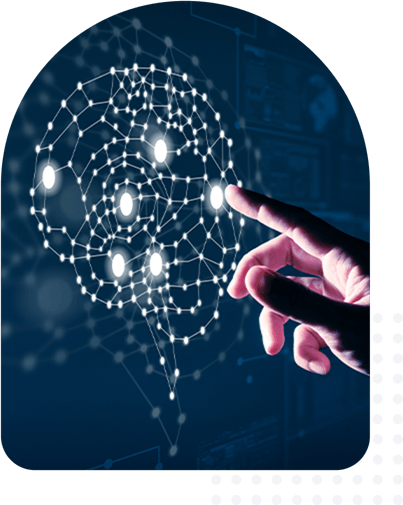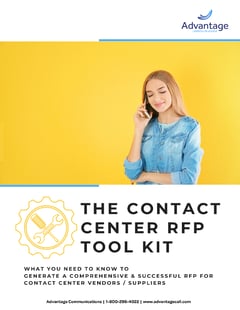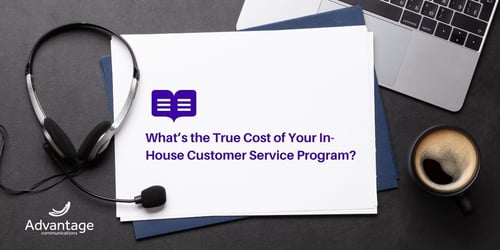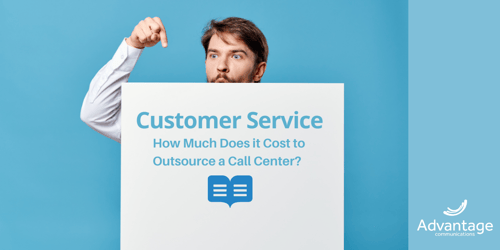Call Center Customer Service Outsourcing - Your Complete Guide
Looking to outsource your customer service strategy to a highly-skilled third party?

.png?width=1920&height=208&name=accent-curve-bottom@2x@2x%20(1).png)
Chapters
Introduction
No matter the size of your business, what industry you serve, and whether you sell a product or service, your customer reputation relies heavily on delivering exceptional customer service that delights your clients.
Unfortunately, most businesses simply do not possess the resources, time, money or know-how to do this successfully. This is why outsourcing your customer service to a contact center can revolutionize your business and empower you to deliver world-class customer service.
By partnering with an outsourced contact center that fits perfectly with your company, you’ll be able to offer a superior customer experience (CX), scale your business for seasonal demand, create an omnichannel approach to customer service, access innovative technology such as artificial intelligence (AI) and much more.
This page will focus on giving you everything you need to know to outsource your customer service program to the right outsourced contact center. We hope this page helps you find the perfect contact center partnership!
What is an Outsourced Contact Center?
To get this page kick-started, let’s first take a look at what an outsourced contact center actually is, and how partnering with such a company can benefit your business.
Contact center outsourcing is the process in which businesses partner with a third-party organization to staff and manage their entire, or certain aspects, of their customer experience and customer service strategy.
Contact centers are typically based in a different location from the business, and use expert knowledge, specialized technologies and highly-skilled customer service agents to achieve excellent customer service outcomes.
By leveraging industry experience, BPO knowledge, customer service expertise and innovative contact center technologies, this partner is able to implement a customer service strategy that drives up customer satisfaction, improves customer loyalty, and saves your business money.
Outsourced contact centers focus on an omnichannel customer service program, delivering world-class customer experiences across a number of different channels.
The key benefits of outsourcing your customer service program to a contact center include:
- Reduced costs.
- Competitive advantage.
- Omni-channel customer service.
- Free up in-house resources.
- Superior customer experience.
The First Step - Creating an Outsourced Contact Center RFP
By outsourcing your call center to a third party, you will be putting the reputation of your brand, as well as your customer satisfaction, in the hands of an outsourced contact center professional.
This means it’s essential that you trust them, and that they are able to have a direct impact on your business - meeting appropriate key performance indicators (KPIs) and offering a great return on investment (ROI).
This huge business decision should be managed through a formal request for proposal (RFP) process.
What is an RFP?
An RFP is a document that an organization - often a large enterprise or government agency - uses to elicit bids from potential vendors in order to procure a product or service through the responding business proposals.
Many people are familiar with the term request for proposal, and many people have even contributed to one in some way, but the vast majority of people do not truly know how to create an RFP.
The RFP specifies what the business is looking for and describes each evaluation criterion on which the vendor’s proposals will be assessed. The RFP is designed to bring structure and transparency to the procurement decision, while reducing risk through open requirements and discussion.
An RFP will generally include:
- Background on the company and its lines of business.
- Specifications that describe the sought-after solution.
- The scope of work and deliverables.
- Technical requirements and the technologies that will be needed.
- The budget.
- Evaluation criteria that describe how proposales will be graded.
This document will allow your business to compare vendors, empowering you to make an informed and objective decision that will help you find the perfect outsourced call center for your company’s unique needs.
How can my business create an RFP for an outsourced contact center?
Many people are familiar with the term request for proposal, and many people have even contributed to one in some way, but the vast majority of people do not truly know how to create an RFP. Your RFP process should include:
1 - Start with an RFI
If you have the luxury of time on your side, the RFP process is best started with a request for information (RFI).
An RFI is a business process which aims to collect written information about the capabilities of various suppliers. The format of an RFI allows the document to be used to compare a large number of vendors that could provide your company with an outsourced call center solution.
The RFI is sent to a broader pool of vendors than an RFP, allowing your company to narrow the list of contenders and proceed to the RFP process with more knowledge and a better idea of what you are looking for.
2 - Introduce your company to the vendor
The first two steps of creating your RFP should be focused on introducing your company to the vendor, explaining what services you are looking for and what you are expecting the outsourced contact center to achieve.
It’s first important to lay out your instructions for responding to the RFP, giving vendors an overview of the RFP process and showing them a clear timeline of when you expect to complete that process.
Secondly, you should introduce your company and the service requirements that you are looking for. This will include information about your business and target audience, as well as laying out everything you expect the contact center to do on your company’s behalf, how they will fit into your company’s overall processes and what you expect them to achieve.
3 - Make sure you get comparable data
The rest of your RFP should be designed as a questionnaire, allowing you to receive data and information in a consistent and easy-to-compare format. This is where you will get them to tell you everything you want to know, and will allow you to compare each vendor side by side.
The rest of your RFP should be made up of:
Vendor organizational description: This will include a detailed description of the vendor’s business, allowing you to determine if they will make a good partner. This should include how they do business, where they are located, their core philosophies and what other similar projects that they have done in the past.
Program management: This is a detailed description of how they will manage the overall project, including issue resolution, their use of employees, workflow and much more.
Tracking and systems: Want to set some minimum expectations to ensure your outsourced contact center is performing to its optimum level? This section will allow you to ask some questions on the contact center’s tracking abilities - helping you to understand how they use call monitoring, data management and other reporting capabilities to track overall project and agent performance.
Pricing and general: What will the service cost, how long will the project last, what are the contract details and are there any additional pieces of information not covered in the previous questions? This last section of your RFP is the time to ask!
4 - Send out your RFP
Once your RFP is finished, it’s now time to send it out to potential contact centers with an invitation to participate. You can send the RFP to as many, or as few, outsourced contact centers as you’d like - but remember, your RFI should have helped you to narrow the field to a few select companies that are better suited to your needs.
The Contact Center RFP Tool Kit
Ready to outsource your contact center customer service to a new vendor / partner? We put together this Contact Center RFP tool kit to help.

How to Create a Contact Center SOW
Once you find an outsourced call center to partner with through your RFP process, it’s time to create a statement of work (SOW).
A SOW is a highly important aspect of both project and contract management. It will help your business guarantee that outsourced customer service will be undertaken according to specific guidelines and expectations set by your company.
The outsourced call center you choose to work with will use this SOW to guide their work during the course of your partnership. It will ensure that an outsourced call center outside of your organization can effectively work with your internal team to revolutionize your approach to customer service and transform your brand’s CX.
What exactly is a SOW?
A SOW is a formal document that is used by an employer to explain the expectations of a service provider. The SOW will include the scope of work, deliverables, timelines, work activities, expected outcomes, projects as well as the payment for the work that’s being performed.
While in this case it will be designed specifically for your outsourced call center, SOWs in general are used for a group of established, and emerging, outsourced solutions that address your company’s needs to source and manage services from a range of different suppliers and vendors.
These services could include anything from advertising, IT, staffing agencies to marketing and much more.
How do I create an outsourced call center statement of work?
While a statement of work isn’t overly complicated to create, for many organizations that have never written one before it can be a daunting task.
A SOW should act as the framework for your relationship with an outsourced call center. The specific directions and instructions, along with the established requirements, tasks and conditions of a SOW, will help objectives to be clearly understood by both parties - and that will lead to customer service success.
To help you create a SOW that will clearly and concisely explain your expectations when working with an outsourced call center, here are some tips:
Start with the basics: Your starting point of a SOW should be a description of the project and the exact services that you are outsourcing. This will include everything from a breakdown on the roles within the project, billing and payment information, liabilities, insurance, compliance, confidentiality and the infrastructure and technology responsibilities.
Clearly define your objectives: The most important aspect of your SOW is to clearly explain the key performance indicators (KPIs) that you want to achieve with your outsourced call center partnership. Once they know what you want to achieve, your customer support partner can put the required resources into meeting those goals by using innovative new technologies such as contact center artificial intelligence (AI).
Use data to ensure a successful partnership: Every strategic partnership leverages data to constantly strive for improvement, and your SOW should lay out exactly how metrics will be used and analyzed. Think about how data can be used to ensure your company and your customer service partner is hitting customer experience and customer journey targets.
Adjust expectations where needed: Your business won’t always stand still, and neither should your partnership. As your outsourced call center works to develop a superior customer experience for your brand, you should always be working on continuous improvements.
Adjust metrics and quarterly goals to ensure your expectations are aligned with the work that your outsourced contact center is doing.
Best Practices to Help Your Brand Transition to Customer Service Outsourcing
While your chosen outsourced call center will be highly skilled in customer service strategies and adapting to different companies, they will still need your help when it comes to knowledge transfer and learning about your brand if you want to see optimum results.
Here are four best practices that will help you work with your new outsourced call center to focus on agent training and contact center knowledge transfer.
1 - Share your team’s knowledge
There isn't anyone that knows your company better than the passionate team members that you employ and who work for you on a day-to-day basis. These staff members can help share information with call center agents about any aspect of your business, from processes, brand identity, customer service patterns and much more.
By moving this knowledge from one team to another, you will empower outsourced contact center agents to become brand ambassadors for your company - allowing them to seamlessly work as an extension of your business.
2 - What makes your brand unique?
Your brand is unique, and there are probably a few things that ensure you stand out from your competitors. Make sure that your outsourced contact center understands exactly what’s different about your company and what your vision is - both in terms of big-picture goals and daily KPIs.
Communicating this vision clearly will ensure the outsourced agents working for your organization understand everything there is to know about your brand’s story, your company culture, your company’s voice, values and how you interact with your customers.
Customer engagement is key to how your customers will see your brand both now and in the future, so your call center must be on the exact same wavelength as your company’s vision.
3 - Have some input into the training process
Training customer service agents is a highly-specialized skill that contact centers have mastered, but that doesn’t mean you can’t get involved in the process. In fact, by taking a hands-on approach to the training process your brand can ensure successful knowledge transfer to the agents handling your customer service strategy.
Call centers will already have highly skilled trainers and professionally designed training programs, but by taking some time to send a subject-matter expert to your outsourced contact center you’ll be able to share critical information straight from the horse's mouth.
4 - Keep communication channels open
Good relationship management with your outsourced call center is crucial. Not only does your business want to contact the call center in an emergency, but the call center will also want to get in touch with you if there are any problems identified.
Good communication will also help you to keep track and monitor your existing knowledge transfer and update that information with your outsourced call center as your brand grows and evolves.
Key Metrics to Look Out For When Outsourcing Your Contact Center
Keeping track of customer satisfaction and loyalty is key, even after you have outsourced your customer service to a call center. It will give your organization vital feedback on how your customer service is performing and which aspects you can improve upon. It's exactly how you will benefit if your business decides to outsource your call center.
While an outsourced call center will calculate a number of significant metrics for your company, it’s still a good idea to do some research to know what these mean. This will empower you to know exactly how your outsourced call center is performing and how they are benefitting your business.
Here are some key metrics to look out for:
1- First-call resolution (FCR)
First call resolution (FCR) is a highly important part of your organization’s customer service and is an essential metric for outsourced call centers. The term itself is pretty self-explanatory. FCR is a call centers ability to address the customer’s needs in a single contact, eliminating the need for the customer to follow up on their issue.
Once FCR has been achieved the customer no longer needs to contact the contact center again about their resolution and a customer service representative will not need to follow up on the query. The issue is completely resolved.
2 - Customer Satisfaction (CSAT)
CSAT is a traditional way to predict customer loyalty and can measure how happy or satisfied a customer is with your business, your product or your customer service interaction.
A company's CSAT score is determined by asking customers a single question, a set of queries, or a long survey to assess their experiences - this is then quantified and expressed as a percentage between 0 and 100 percent. The higher the percentage the more satisfied your customers are with your company.
3 - Net Promoter Score (NPS)
NPS is a metric that has increased in popularity over the past decade, and the idea behind it is that the willingness to give a word-of-mouth recommendation is a good predictor of customer loyalty.
NPS aims to find out how likely a customer will act as an ambassador of your brand, recommending your product or services to other people within their network.
4 - Customer Effort score (CES)
Ever wondered how much work a customer has to go to in order to purchase your products or services? That’s exactly what CES measures. This popular metric looks at the difficulty a customer faces when trying to buy from your organization.
5 - Call abandonment rates (CAR)
CAR measures the number of calls abandoned by customers before they even connect with a customer service agent. Higher CAR rates are an early warning that customers might be shifting their loyalties to one of your competitors.
6 - Average handle time (AHT)
While it’s good for agents to be conversational and friendly, your customers want fast and concise customer service that answers every single question they have as efficiently as possible. That’s why it’s important the average call time is neither too low nor too high.
Average handling time is a metric used to measure the amount of time required to handle a call, giving insight into how efficient your customer service processes are. This time includes talk-time, hold-time and hang-up time.
7 - Service level
Service level measures the number of calls that are answered within a given time. The traditional service level in the contact center is to answer 80 percent of calls in 20 seconds. However, over recent times, many contact centers have made an effort to improve service levels by attempting to answer 90 percent of calls in 15 seconds.
Despite this, there are contact centers that are willing to let customers wait a little longer in the queue, to focus on giving them the best possible service once they reach an advisor.
That’s not to mention that service levels differ across channels. While we have highlighted the traditional service level for the voice channel, conventional service levels are different for other contact center channels?
Here is a list of the conventional service levels of five other contact center channels.
- Email – 95 percent of emails are answered within four hours (the better contact centers are aiming to respond to 80% of emails within 15 minutes).
- Live chat – 80 percent of chats answered within 40 seconds.
- Letters – 95 percent of letters answered within three days.
- Social media – 80 percent of contacts answered within 20 minutes.
- SMS/messaging apps – 80 percent of messages responded to within 40 seconds.
This metric gives an important insight to call centers in terms of how many agents they need for a particular client at any given time, in order to lower queue times for customers.
The Contact Center RFP Tool Kit
Ready to outsource your contact center customer service to a new vendor / partner? We put together this Contact Center RFP tool kit to help.

What is the Cost of Contact Center Outsourcing?
Working with an outsourced contact center should have two primary benefits, to improve your customer service program and reduce costs. So, how much does an outsourced customer service program cost?
Building an in-house customer service program in complex, involves investment in highly-skilled agents (that are not easy to hire), experience in building successful customer experience and further investment in advanced contact center technologies.
Most organizations simply don’t have the resources, time or expertise to implement these internally.
That’s why outsourcing to a contact center is cost-effective since they already have the process, agents, expertise and technologies in place. They’ll not only improve your customer service offering, but they’ll find efficiencies in your processes that significantly reduce costs.
In reality, that depends entirely on what you need to outsource and what your business is trying to achieve. There are a number of things that impact how much a contact center costs, including:
- Locations
- The services that you require
- The goals you are trying to achieve
- The volume of customer service queries you receive
- Whether you work with a shared or dedicated call center
The only way to really understand the cost of an outsourced contact center program is to send out an RFP that explains your specific goals and requirements.
Why You Should Consider a Nearshore Contact Center Solution
Offshore call centers offer your company lower transaction costs, but will your business really see true return in value from these solutions? In the current market, customers expect more and that’s why your investment will go further with nearshore contact center solution.
Not only will a nearshore solution, such as a company based in Canada or Jamaica, provide fantastic return on investment and customer satisfaction scores, they are likely to be leading the way in new contact center innovations and techniques.
Here are three key reasons you will benefit from outsourcing your customer service to a nearshore contact center:
1 - Close proximity to major markets
Both Jamaica and Canada are located within close proximity to major markets with similar time zones, allowing contact centers in these countries to easily and efficiently work with high-profile clients in both Canada and North America.
This means Jamaican and Canadian call centers are able to work with your business closely, setting up times for meetings that work for you and even meeting in person where necessary. The major benefit of this is that these nearshore contact centers can work in real-time with your business to ensure customer support strategies are perfectly tailored for your company’s needs.
2 - Friendly by nature
Known for their hospitality and friendly nature, it really is true that both Canadians and Jamaicans are polite by habit. This politeness is something these societies are taught from a young age, and they are told by their parents that it’s essential to life - but it’s also essential to business.
Successful customer service relies heavily on the personality of your customer support representatives - including how they address customers, how they deal with complaints and how they empathize with those calling into your business.The naturally friendly personas of Canadian and Jamaican agents mean they are perfectly suited to superior customer service.
3 - Access to a highly educated workforce
Both Jamaica and Canada offer a highly educated workforce with an excellent blend of world-class education and hands-on experience. This, combined with strong local spirit and a positive attitude towards building relationships, exceptional loyalty, and genuine enthusiasm, means the country is a recipe for customer service success.
The engaged and experienced talent pool in both countries have a wide range of skills, from help-desk and technical support to sales and customer service.
How to Outsource Your Customer Service with Advantage Communications
Now your business understands the key aspects of partnering with a contact center, Advantage Communications Inc. (ACI) has created a five-step process that your company can expect when choosing ACI as your outsourced contact center expert.
Step 1 - Discovery
Great partnerships are built on communications! During this phase, we’ll chat with you about your goals and current customer service offering. You’ll learn about our innovative, game-changing solutions. Let’s explore ways to PowerUp your contact center together!
Step 2 - Planning
Studies show 39 percent of projects fail due to lack of planning and resources! That’s why this phase of our engagement with you is of paramount importance. We know how to get it right! Let’s set up your implementation for success!
Step 3 - Preparation
It’s time to build your system and program! We’re experts at technology integrations and implementing omni-channel customer service solutions. Seamless connections optimized for your operations. During this phase we’ll also get ready for training!
Step 4 - Training
This is where it all comes together. The plan is realized and you can see, hear, and operate the entire system in a training environment. But, what’s more - you will get a feel for the customer experience, delivered by agents trained to be polite, helpful brand ambassadors.
Step 5 - Launch
Your new contact center is live and ready to deliver the latest omni-channel customer service! With top-notch communications, accurate planning and expert technology execution and training - we want to hear the implementation was easy and effective.
Here at Advantage Communications, we are building partnerships and bridges for long-term success! Now is the time to start enjoying the plethora of benefits that come with outsourcing your customer service strategy.
.png?width=1920&height=208&name=accent-curve-top@2x%20(1).png)
.png?width=500&name=image%20(6).png)





.png?width=500&name=image%20(7).png)

.png?width=500&name=image%20(8).png)


.png?width=500&name=image%20(9).png)




